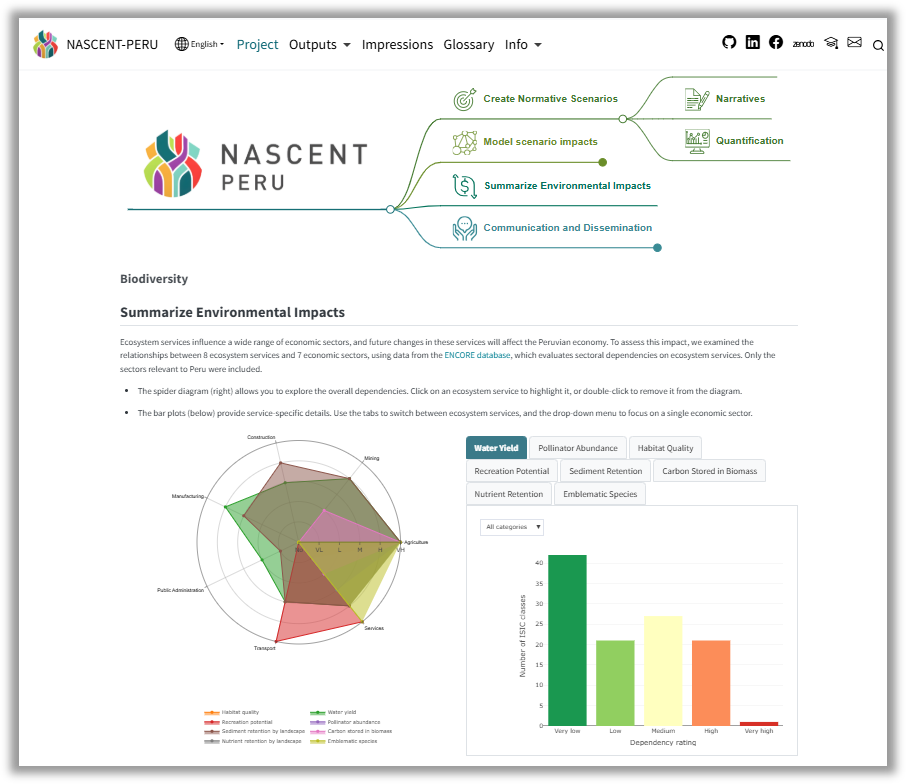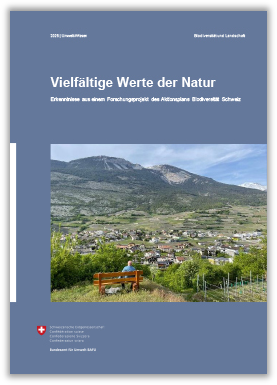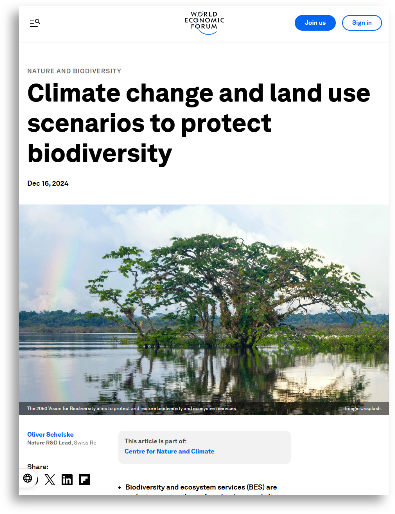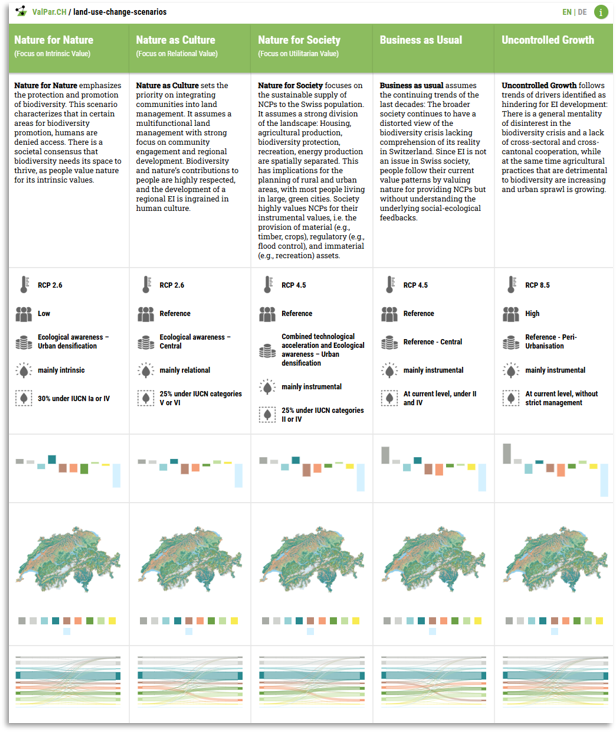Journal Articles
In review
-
Roman, O., Adey, B. T., Black, B., Zeindl, E. Where will the change come from? Identifying decision-relevant factors in future Land Use and Cover Change (LUCC) scenarios to support planning under uncertainty. Futures.
-
Wicki, S., Black, B., Külling, N,, Kurmann, M., Wang, J., Lehmann, A., Grêt-Regamey, A. Temporal Archetypes of Nature’s Contributions to People for Sustainable Landscape Development. Regional Environmental Change.
-
Bell, A., Troost, C., Filatova, T., Vincenot, C., Qin, C., Fiedler, S., Lemmen, C., Lynch, I., Pierce, M., Edmonds ,B., McIntire, E., Wang, H., Koralewski, T., Grant, W., Wang, M., Black, B., Grimm, V. The PAVE pathway: how to talk about models with people who did(n’t) build them. Bioscience.
-
Black, B., Adde, A., Külling, N., Büth, C., Kurmann, M., Lehmann, A., Altermatt, F., Guisan, A., Gret-Regamey, A. Identifying robust conservation stragies to secure ecosystem service provision under uncertainties. Journal of Environmental Management.
Preprint Code
2024
-
Black, B., Adde, A., Farinotti, D., Guisan, A., Külling, N,, Kurmann, M., Martin, C., Mayer, P., Rabe, SE., Streit, J., Zekollari, H., Grêt-Regamey, A. Broadening the horizon in land use change modelling: Normative scenarios for nature positive futures in Switzerland. Regional Environmental Change. https://doi.org/10.1007/s10113-024-02261-0.
Cite Data Code📝 Overview
This research explores how to model future land use in Switzerland using scenarios that focus on positive outcomes for nature and society. Instead of simply predicting what might happen, we created five future scenarios—three "normative" (based on goals) and two "exploratory" (based on trends). They used a sophisticated spatial simulation model to test how different choices might shape the landscape between 2020 and 2060.
🔍 Key Findings
- Normative scenarios led to more sustainable landscapes compared to business-as-usual or worst-case scenarios.
- Urban expansion and landscape fragmentation were much higher in exploratory scenarios.
- Protected area expansion and land use zoning helped maintain ecological connectivity and reduce sprawl.
- Expert feedback was mixed: while useful, users found it hard to engage with highly detailed simulation maps.
- Key challenge: making spatial simulation results easily interpretable for strategic decision-making.
🧪 Methods
- Five future scenarios were simulated using a Land Use and Land Cover Change - Constrained Cellular Automata (LULCC-CCA) model.
- Inputs were derived from expert workshops, demographic projections, climate models, and economic data.
- Each scenario was defined by different values and goals, aligned with the IPBES “Nature Futures Framework.”
- Scenario elements included:
- Dynamic climate and population drivers
- Land use transition rules and probabilities
- Spatial interventions like zoning and protected areas
- Model validation included comparison with historical land use and feedback from experts via an interactive web platform.
🌱 Implications
- Normative scenarios support sustainability: This approach can help plan land use that protects biodiversity and ecosystem services.
- Participatory modelling is essential: Combining expert and stakeholder input ensures models reflect diverse values.
- Better communication tools are needed: To involve more people in decision-making, simulation results must be clearer and more accessible.
- Future planning can benefit from scenario modelling by identifying trade-offs and synergies before decisions are made.
2023
-
Wicki, S., Black, B., Kurmann, M., Grêt-Regamey, A. Archetypes of social-ecological-technological systems for managing ecological infrastructure.. Environ. Res. Lett.. https://doi.org/10.1088/1748-9326/ad1080.
Cite📝 Overview
This study explores how ecological infrastructure (EI)—like wetlands, forests, and green spaces—can be better planned and managed in urban areas. Using Geneva, Switzerland as a case study, we applied a systems-based approach combining social, ecological, and technological data to create spatial archetypes. These archetypes help identify how different types of landscapes function and what strategies might work best to support nature and human well-being.
🔍 Key Findings
- Seven distinct landscape archetypes were identified across Geneva, such as “Concrete Jungle” and “Green Frontier.”
- There is a strong disconnect between ecological conditions and social/technological systems in dense urban areas.
- Some archetypes (e.g., Cultivated Oasis) offer high ecological benefits and biodiversity, while others (e.g., Concrete Jungle) are underperforming ecologically.
- Tailored management strategies are needed for each archetype, considering their social and ecological roles.
- Stakeholders emphasized the importance of collaboration, incentives, and spatial planning to implement EI effectively.
🧪 Methods
- Used a Social-Ecological-Technological Systems (SETS) framework with high-resolution spatial data (25m grid).
- Gathered data on biodiversity, infrastructure, demographics, and ecosystem services (Nature’s Contributions to People).
- Applied machine learning (PCA and clustering) to group Geneva’s landscape into 7 archetypes based on SETS variables.
- Engaged stakeholders in interviews and workshops to validate data and develop policy recommendations per archetype.
- Mapped current and projected land use change (to 2060) to understand potential pressures and trends.
🌱 Implications
- Local strategies for diverse areas: Each archetype needs context-specific management approaches.
- Integrated planning is key: Social and ecological systems must be aligned through smart design and regulation.
- EI is not one-size-fits-all: Policies should reflect regional variation in land use and biodiversity potential.
- Stakeholder engagement is essential: Co-producing knowledge ensures practical, accepted solutions.
- Transferable approach: This archetype method can be applied to other urban regions worldwide to guide sustainable land use.
2022
-
Black, B., Strien, M.J. van, Adde, A., Grêt-Regamey, A. Re-considering the status quo: Improving calibration of land use change models through validation of transition potential predictions.. Environmental Modelling & Software. https://doi.org/10.1016/j.envsoft.2022.105574.
Cite Preprint Code📝 Overview
This study explores how land use and land cover change (LULCC) is predicted using models called cellular automata. Typically, models are only evaluated after they simulate changes, but this paper shows that checking the predictions earlier in the process—called stage 1 validation—can make models more accurate and easier to understand.
🔍 Key Findings
- Stage 1 validation improves transparency: Early checks reveal problems hidden in final map-only evaluations.
- Not all transition models perform equally: Some predictions were unreliable despite using advanced methods.
- Individual model checks help: Looking at transitions separately exposes weak areas like data imbalance.
- Predictor selection improves models: Removing unnecessary inputs improved performance, especially for logistic regression.
- Random Forests generally outperformed Logistic Regression, but were less sensitive to input refinement.
🧪 Methods
- Study Area: Land cover transitions across Switzerland from 2009 to 2018 were analyzed.
- Data: Swiss national land use datasets were combined with environmental and spatial predictors (e.g., elevation, soil, roads).
- Models: Transition potential (TP) models were built using Logistic Regression and Random Forests for 174 specific land change scenarios.
- Validation:
- Stage 1 validation: Assessed how well TP models predicted transition probabilities before simulation.
- Stage 2 validation: Compared simulated maps to observed maps (used less in this study).
- Performance Metrics: ROC AUC and Boyce Index were used to evaluate model accuracy and generalizability.
- Variable Selection: A two-step method reduced redundant predictors, tested for model performance and efficiency.
🌱 Implications
- More efficient calibration: Stage 1 saves time by avoiding full simulations for every tweak.
- Improved interpretability: Helps users understand and trust predictions, important for policy-making.
- Need for better tools: A shared calibration protocol would benefit land change modelling broadly.
- Supports sustainable planning: Better models mean better decisions for urban growth, agriculture, and nature.
-
Black, B., Anthony, B.P. Counterfactual assessment of protected area avoided deforestation in Cambodia: Trends in effectiveness, spillover effects and the influence of establishment date.. Global Ecology and Conservation. https://doi.org/10.1016/j.gecco.2022.e02228.
Cite Code📝 Overview
Forests play a vital role in maintaining ecological balance by storing carbon, supporting biodiversity, and regulating climate patterns. However, rapid deforestation—caused by agriculture, infrastructure development, and illegal logging—poses a significant threat to these ecosystems. To counteract this issue, governments and conservation organizations have established protected areas (PAs), which are designated regions where land use is restricted to prevent forest loss. While these areas are intended to preserve forests, their effectiveness is often uncertain. This study aims to evaluate whether Cambodia’s protected areas have successfully reduced deforestation and to what extent they contribute to conservation efforts.
🔍 Key Findings
- Protected areas have had a measurable impact on reducing deforestation, but their success varies widely based on location, enforcement, and external pressures.
- Some PAs significantly reduced deforestation, particularly those with strong legal enforcement and active management strategies.
- Many PAs located in high-risk areas (e.g., near expanding agricultural zones and infrastructure projects) were more effective than those in remote, less-threatened regions.
- Despite legal protection, deforestation still occurred within some PAs, often due to weak enforcement, illegal logging, or encroachment for agricultural use.
- The study also found that some PAs were established in areas where deforestation risk was already low, making their protective impact appear greater than it actually was.
🧪 Methods
Rather than simply comparing protected forests to unprotected ones, this research employed a method known as counterfactual analysis. This technique helps estimate what would have happened if no protections had been put in place. By doing so, the study provides a more accurate assessment of the real impact of protected areas. Without using this approach, it is difficult to determine whether a protected forest remains intact because of conservation policies or simply because it was never at high risk of deforestation.
To conduct this analysis, satellite imagery and deforestation data were examined across different regions in Cambodia. Various factors were considered, including land-use policies, road proximity, human population density, and historical deforestation trends. By comparing observed deforestation within PAs to a predicted scenario without protections, the study was able to isolate the true impact of conservation efforts.
🌱 Implications
- Understanding how well protected areas function is critical for improving conservation strategies. If some PAs are not successfully reducing deforestation, it may indicate a need for better enforcement, improved land management policies, or the establishment of protection in higher-risk areas.
- This study highlights the importance of using data-driven approaches to evaluate conservation outcomes and ensure that resources are directed toward efforts that have the greatest impact.
- By refining the selection and management of protected areas, policymakers and conservationists can enhance their effectiveness, ensuring that Cambodia’s forests continue to provide ecological, economic, and social benefits for future generations.
- This research underscores the need for scientific assessments in conservation planning. By continually monitoring and adapting conservation policies based on evidence, we can create more effective strategies to combat deforestation and preserve Cambodia’s rich forest ecosystems.
Theses
-
Black, B. Identifying effective area-based conservation strategies under uncertainty Doctoral thesis. ETH Zürich. Not presently available
Cite -
Black, B. Assessing the ecological effectiveness of protected areas in Cambodia: a quasi-experimental counterfactual estimation of avoided deforestation. Masters thesis. Central European University. https://doi.org/10.13140/RG.2.2.28621.10727
Cite -
Black, B. Simulating the future potential of degraded Mangrove plots using field data from Kenya. Bachelors thesis. Edinburgh Napier University. https://doi.org/10.13140/RG.2.2.20232.49923
Cite
Student theses supervised
-
Wang, J. 2024 Mapping spatial pattern of changes in Nature’s Contributions to People under multiple scenarios in Switzerland, 2020-2060. Masters thesis. ETH Zürich.
-
Streit, J. 2023 The development of a functioning Ecological Infrastructure in agricultural landscapes in Switzerland: A social-ecological systems perspective. Masters thesis. ETH Zürich.
-
Gao, T. 2022 Characterizing concept drift in predictive models of land use transitions in Switzerland Masters thesis. ETH Zürich.
-
Wild, J. 2022 Examining temporal instability in historic land use change in Swiss cantons to inform modelling Bachelors thesis. ETH Zürich.
-
Wang, J. 2021 Bayesian Networks to map Nature’s Contribution to People (NCP) and driving factors analysis Masters thesis. ETH Zürich.



